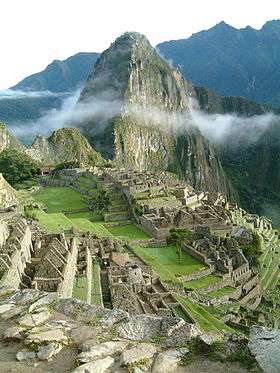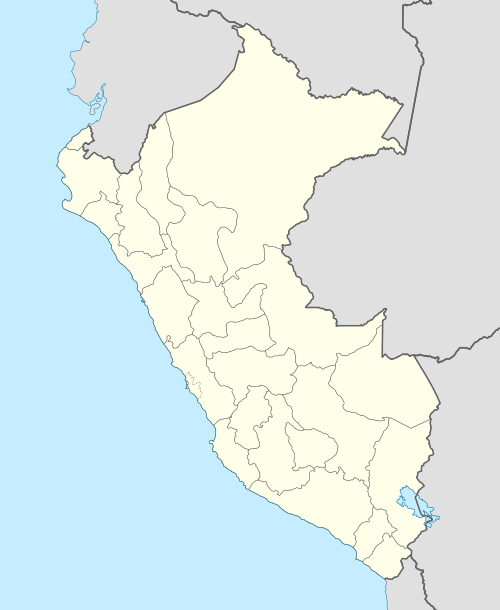Huayna Picchu
| Huayna Picchu Wayna Pikchu | |
|---|---|
 Sunrise over Huayna Picchu towering above the ruins of Machu Picchu | |
| Highest point | |
| Elevation | 2,720 m (8,920 ft) |
| Prominence | 360 m (1,180 ft) |
| Coordinates | 13°09′27″S 72°32′50″W / 13.15750°S 72.54722°WCoordinates: 13°09′27″S 72°32′50″W / 13.15750°S 72.54722°W |
| Geography | |
 Huayna Picchu Wayna Pikchu | |
| Parent range | Andes |


Huayna Picchu, Wayna Picchu (Hispanicized spellings) or Wayna Pikchu (Quechua wayna young, young man, pikchu pyramid, mountain or prominence with a broad base which ends in sharp peaks,[1][2] "young peak") is a mountain in Peru around which the Urubamba River bends. It is located in the Cusco Region, Urubamba Province, Machupicchu District.[3] It rises over Machu Picchu, the so-called lost city of the Incas, and divides it into sections. The Incas built a trail up the side of the Huayna Picchu and built temples and terraces on its top. The peak of Huayna Picchu is about 2,720 metres (8,920 ft) above sea level, or about 360 metres (1,180 ft) higher than Machu Picchu.
According to local guides, the top of the mountain was the residence for the high priest and the local virgins. Every morning before sunrise, the high priest with a small group would walk to Machu Picchu to signal the coming of the new day. The Temple of the Moon, one of the three major temples in the Machu Picchu area, is nestled on the side of the mountain and is situated at an elevation lower than Machu Picchu. Adjacent to the Temple of the Moon is the Great Cavern, another sacred temple with fine masonry. The other major local temples in Machu Picchu are the Temple of the Condor, Temple of Three Windows, Principal Temple, "Unfinished Temple", and the Temple of the Sun, also called the Torreon.[4]
Tourism
The number of daily visitors allowed to enter Huayna Picchu is restricted to 400. Advance purchase of tickets online will guarantee admission. A steep and at times exposed climb leads to the summit. Some portions are slippery and steel cables (a via ferrata) provide some support during the one-hour climb. You can climb Huayna Picchu all year round. The climbing is more challenging between November and April because the ascent route becomes slippery due to the rain season. You can expect better conditions for climbing during the dry season that run from May to September.
At times during the rainy season, the tours are closed. The climb is not recommended for visitors in poor physical condition.
From the summit, a second trail leads down to the Gran Caverna and the Temple of the Moon (a misnomer).[5] These natural caves, on the north face of the mountain, are lower than the starting point of the trail. The return path from the caves completes a loop around the mountain as it rejoins the main trail.
See also
- Phutuq K'usi
- Aguirre, the Wrath of God, a 1972 film filmed partly on the stone stairway of Huayna Picchu.[6]
 Machu Picchu travel guide from Wikivoyage
Machu Picchu travel guide from Wikivoyage
References
- ↑ Teofilo Laime Ajacopa, Diccionario Bilingüe Iskay simipi yuyayk'ancha, La Paz, 2007 (Quechua-Spanish dictionary): wayna - adj. s. m. Joven. Hombre que está en la juventud. pikchu - s. Pirámide. Sólido puntiagudo de varias caras. || Cono. Ch'utu.
- ↑ Diccionario Quechua - Español - Quechua, Academía Mayor de la Lengua Quechua, Gobierno Regional Cusco, Cusco 2005: wayna - s. Joven, mozo, adolescente, hombre de 18 a 30 años. SINÓN; q'aqo. pikchu - s. Geog. Pirámide. Cerro o prominencia de base ancha que termina en puntas afiladas. Waynapikchu - s. Arqueol. (Cerro o pico joven) Grupo arqueológico ubicado en la cresta del cerro del mismo nombre, ... Waynapikchu - s. Zool. (Oncideres poecila Bates) Escarabajo serruchador. Orden coleóptera. Familia cerambyeidae. Escarabajos pequeños o grandes, aplanados o cilíndricos con antenas largas, pinzas bucales poderosas que cortan ramas de naranjos, paltos y cacaoteros. || Bot. (Galactia speciosa) Planta herbácea de la zona de ceja de selva.
- ↑ escale.minedu.gob.pe - UGEL map of the Urubamba Province (Cusco Region)
- ↑ Wright, Ruth M. & Valencia Zegarra, Alfredo. (2004) The Machu Picchu Guidebook. Revised edition. Boulder, CO:Johnson Books.
- ↑ "The Temple of the Moon". Peru Culture. Retrieved 2010-12-05.
- ↑ Herzog, Werner. Herzog on Herzog, edited by Paul Cronin, Faber & Faber, 2003. ISBN 0-571-20708-1
External links
- Lumbreras, Luis. Wayna Picchu, the "young mountain" Peru Virtual Cultural Center (Perucultural.org.pe), with supporting media and bibliography.